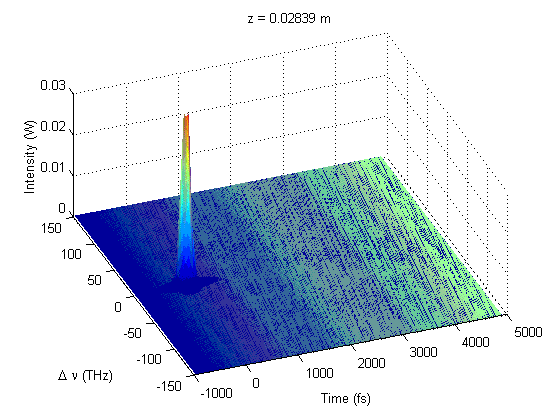Ultrafast Optics
Femtosecond Fiber and Solid-State Sources
Femtosecond technology drives innovation fundamentally, as with the study of new ultrafast phenomena, and through applications ranging from precision material processing, to frequency metrology and surgery. The performance of traditional femtosecond sources in terms of stability, cost, energy, pulse duration and peak powers continues to improve. Notably, fiber laser source technology has greatly enhanced the availability of low-cost high performance ultrashort pulsed sources. Research in Professor Renninger’s lab continues to increase the performance of femtosecond sources through traditional and very untraditional techniques. Research directions include new versatile fiber lasers, high power solid-state lasers, and new concepts in mode-locking focused on arbitrary wavelength pulse generation.
Supercontinuum Generation, Mode-locked Lasers, Solitions
Supercontinuum Generation refers to extreme spectral broadening of femtosecond optical pulses occurring when they propagate in the anomalous-dispersion regime of a highly nonlinear fiber. In this case, the combination of various dispersive and nonlinear effects generates a supercontinuum through a process known as soliton fission, followed by the emission of Cheronkov radiation and Raman-induced spectral shifts. Professor Agrawal’s group is studying various physical mechanisms that participate in the process of supercontinuum generation.
Mode-locked fiber lasers produce short optical pulses ranging from 50 fs to tens of picoseconds through a mode-locking technique. Passive mode locking typically produces femtosecond pulses at repetition rates below 50 MHz. The repetition rate can be enhanced through active mode locking by placing a modulator inside the laser cavity. Professor Agrawal's group is currently focused on erbium (Er) and ytterbium (Yb) fiber lasers. Erbium-fiber lasers operate near 1550 nm and are useful for eye-safe applications. Ytterbium-fiber lasers operate near 1050 nm and can provide high optical powers as well as high-energy pulses.
Optical Solitions is an exciting research area. When ultrashort pulses are propagated in the anomalous-dispersion regime of a nonlinear fiber, under certain conditions they can form solitons such that their width and shape does not change along the fiber. Professor Agrawal's group is studying soliton formation and propagation in both passive and active fibers.
Ultrafast Dynamics in Solids, High-Field Sciences
Professor Guo's group is studying ultrafast dynamics of electrons, phonon, and surface plasmons in various materials. His group is also studying fundamental interactions of high-intensity femtosecond laser with matter in various phases, including gas, condensed, and plasma phases.
Professor Dai's research efforts center on ultrafast lasers and phenomena, terahertz optoelectronics, and time-resolved ultrafast spectroscopy. Currently he is working on Terahertz Wave Air Photonics: terahertz wave generation, detection, and manipulation in laser-induced gas plasma. Potential applications include terahertz wave remote sensing and nonlinear terahertz spectroscopy.
